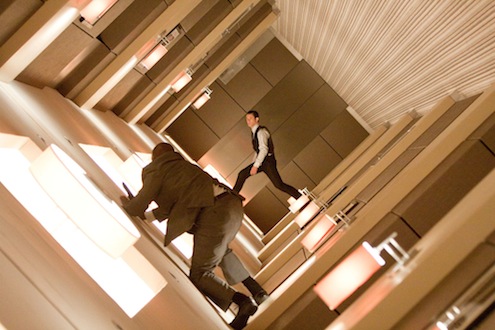
ROYAL WEDDING (1951, Donen)
I love a good in-camera effect, and the ol’ spinning set technique is one of my favorites. Whether it’s in a musical number (Royal Wedding), an action sequence (Inception) or a horror film (Poltergeist), it’s always a thrill. Today’s shot is the immortally famous dance number from Royal Wedding of Fred Astaire dancing on the ceiling, directed by then-26-year-old wunderkind Stanley Donen. Since all that is old becomes new again, we’ll have a glimpse at how Donen’s technique was used to great effect more recently:
But first and foremost, Stanley Donen. What an amazing career he had, having worked professionally in musicals from the age of 16. According to Donen, “I was lucky; everything came easy.” I was reminded of today’s shot by my recent obsession with the Directors Guild of America’s History Project. Slowly but surely, the guild is recording hours and hours of interview footage with film & TV greats after they retire (in most cases) but before they Retire. Some of the interviews are eight hours! This is like cat nip to me, of course, and I find myself joyfully falling down these anecdotal rabbit holes for hours at a time.
If you wanted to hear Stanley talk about today’s shot directly, go here, click on Chapter 2, and jump to 4:05. (Earlier in the chapter hear how no one in Hollywood ever wanted to work with Judy Garland a second time!)
Donen, Nolan & Hooper Hit the Ceiling
Back to the shot. I think movie-goers are well-used to this technique, but this perhaps was the very first application (although there must have been others – as Hugo has taught us recently, there wasn’t a single cinema trick that George Méliès, eg, hadn’t committed to celluloid. Maybe it was in one of his lost films.) Anyhow, I can’t imagine the gasps that Fred’s going vertical that first time must have elicited (no double entendre intended). Donen goes on at length about the importance of rehearsal, and seeing this shot, which is so easy to take for granted, you get an appreciation of how much coordination and expert timing it took to pull off. (Example, the lights had to rotate with the set, which meant all the cables did, too, which must have complicated matters immeasurably.)
Here’s the number. I recommend starting at 1:55 (shot’s at 2:30), and be sure to have a look at the second video, too.
.
Even more exciting for me, I’ve found this wonderful clip on youtube where someone has rotated the film (I love that people do stuff) as the room spins to give us a behind-the-scene glimpse of how it really went down (or up) and what Astaire was really experiencing. This one looks best full screen:
[youtube=http://www.youtube.com/watch?v=i0g3g6AvLtM]
.
Here’s the same youtube trick done on, probably, the most recent example of the rotating-set technique, the hallway scene from Christopher Nolan‘s Inception. Swap out Fred Astaire for one Joseph Gordon Levitt:
[youtube=http://www.youtube.com/watch?v=DF5CnoQPw7A&feature=related]
.
And finally, this topic wouldn’t be complete without a look at the technique in Poltergeist:
[youtube=http://www.youtube.com/watch?v=-bbaplq5MGs&feature=related]

Dan Reisinger
Cant believe I didnt notice the link before…
jsbfilm
Yeah, me neither, Dan. Kinda occurred to me only while I was posting about Royal Wedding and I was researching the technique, and I had the “oh, yeah” moment of the other films.
Helena
<3 Just watched this recently, of course. 🙂 And if I had ever watched Poltergeist, I could have told ya that! Lol! Great post!
jsbfilm
Uh-oh, I’m going to make you watch POLTERGEIST!